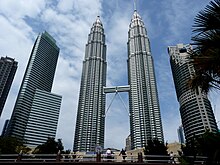Economy of Malaysia

Kuala Lumpur, financial centre of Malaysia.
|
|
| Currency | Ringgit |
|---|---|
| Calendar year | |
|
Trade organisations
|
APEC, ASEAN, IOR-ARC, WTO |
| Statistics | |
| GDP | $815.6 billion (PPP 2015 est.) $296.2 billion (Nominal 2015 est.) |
|
GDP growth
|
5.0% (2015) |
|
GDP per capita
|
$26,300.20 (PPP, 2015 est.) $9,776.206 (nominal, 2015 est.) |
|
GDP by sector
|
(2014) Agriculture: 7.1% Industry: 36.8% Services: 56.2% |
| 3.0% (November 2015) | |
|
Population below poverty line
|
1% (2015) |
| 43.1 (2009 est.) | |
|
Labour force
|
14.04 million (2014) |
|
Labour force by occupation
|
(2012) Agriculture: 11.1% Industry: 36% Services: 53.5% |
| Unemployment | 3.1% (2014) |
|
Main industries
|
List
|
| 23rd (2017) | |
| External | |
| Exports | $175.7 billion (2015 est.) |
|
Export goods
|
electrical & electronic products, palm oil, liquefied natural gas, petroleum, chemicals, machinery, vehicles, optical & scientific equipment, manufactures of metal, rubber, wood and wood products |
|
Main export partners
|
|
| Imports | $207.5 billion (2014 est.) |
|
Import goods
|
electrical & electronic products, machinery, chemicals, petroleum, plastics, vehicles, manufactures of metal, iron and steel products |
|
Main import partners
|
|
|
FDI stock
|
$77.4 billion (31 December 2010 est.) |
|
Gross external debt
|
$213.9 billion (est. 2014) |
| Public finances | |
| Revenues | $65.72 billion (2013 est.) |
| Expenses | $79.4 billion (2013 est.) |
| Economic aid | $31.6 million (2005 est.) |
|
|
|
Foreign reserves
|
US$94.5 billion (August 2015) |
Malaysia has a newly industrialised market economy, which is relatively open and state-oriented. The economy of Malaysia is the fourth largest in Southeast Asia, after the much more populous Indonesia, Thailand and the Philippines, and 35th largest in the world. Malaysia is also the third richest in Southeast Asia by GDP per capita values, after the city-states of Singapore and Brunei. Malaysia's economy is one of the most competitive in the world, ranking 14th in the Ease of Doing Business Index for 2015. Malaysian economy is highly robust and diversified with export value of high-tech products in 2014 stood at 63.3 billion USD, the second highest after Singapore in ASEAN. Malaysia exports the second largest volume and value of palm oil products globally after Indonesia.
Despite government policies to increase income per capita in order to hasten the progress towards high income country by 2020, Malaysia growth in labour productivity and wages has been very slow, lagging behind by the OECD standard. Academic research paper from IMF and World Bank repeatedly called for structural reform and indigenous innovation to move the country up the value chain of manufacturing to allow Malaysia escape the current middle income trap. Due to heavy reliance on oil exports for central government revenue, the currency fluctuations has been very volatile, noticeably during the supply glut and oil price collapse in 2015. However government had step up measures to increase revenue by introducing the widely unpopular Government Service Tax at 6% rate to reduce deficits and meet federal debt obligations.
...
Wikipedia
